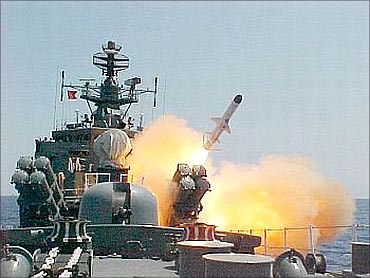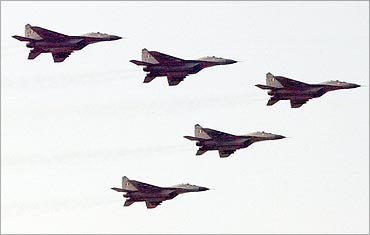Photographs: Reuters
This paragraph (para 116) reads: "In the Budget 2011-12 a provision of Rs. 1,64,415 crore (Rs. 1644.15 billion) has been made for defence services, which include Rs. 69,199 crore (Rs. 691.99 billion) for capital expenditure. Needless to say, any further requirement for the country's defence would be met."
Admittedly, this has been a standard formulation of successive finance ministers for years, however, for a government that spends close to 13 per cent of total government expenditure (though the finance ministry's "Budget at a Glance" document claims it is only 11 per cent) on defence, this is a rather cavalier treatment of one of the most important items of the government's expenditure statement.
Surely, the nation's lawmakers deserve some more details, considering that so many paragraphs of the finance minister's speech have been devoted to an elaboration of so many schemes that together do not even amount to 3 per cent of the total expenditure of the government.
One sentence in Budget speech for 13% spending
Image: Is the Budget neglecting Indian NavyPhotographs: Reuters
That the government does not share too many details about defence spending is understandable up to a point. In fact, it is entirely possible that some part of actual expenditure on equipments acquisition does not even get captured by the Budget data.
That a large part of the total defence Budget is in fact devoted to just salaries and pensions (pensions alone account for Rs. 34,000 crore [Rs. 340 billion]) is of course obvious.
To the extent that data is provided, we know that the Army continues to walk away with a lion's share of total defence spending, followed by Air Force and Navy in that order.
The time has come for the government to explain and defend this pattern of spending. Is the Indian Navy being neglected? In what way does the defence Budget reflect preparation to meet medium to long-term threats to national security?
One sentence in Budget speech for 13% spending
Image: Defence spending lacks transparencyPhotographs: Reuters
Can defence spending be an instrument of industrial policy and technology development? If so, what is the government doing about it?
What are the views of the nation's economic policy makers with respect to the role of the private sector in defence related manufacturing and services industries?
These and many such questions have been repeatedly raised in the public debate on defence and development in India that the finance minister could have tried to address while seeking the Parliament's authorisation to devote as much as 13 per cent of total government spending to defence.
In not doing so, the finance minister has lost an opportunity to bring greater transparency to defence spending.






article